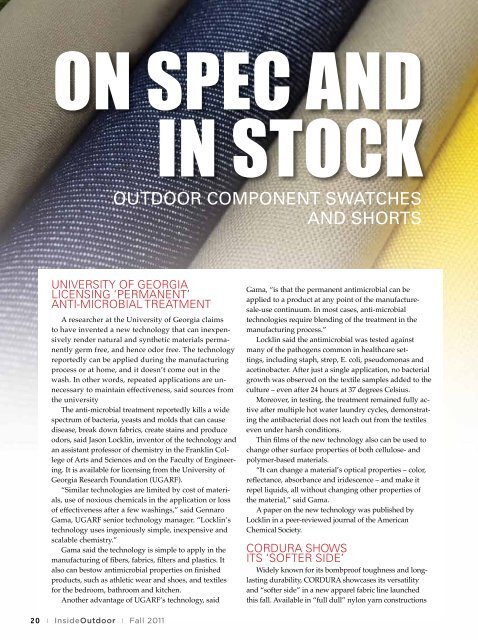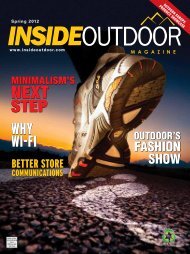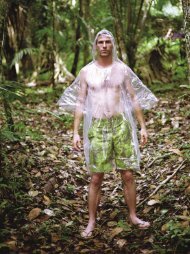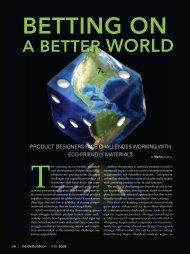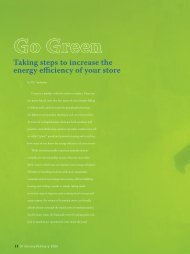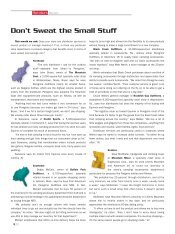Fall - InsideOutdoor Magazine
Fall - InsideOutdoor Magazine
Fall - InsideOutdoor Magazine
Create successful ePaper yourself
Turn your PDF publications into a flip-book with our unique Google optimized e-Paper software.
On Spec and<br />
In Stock<br />
Outdoor component swatches<br />
and shorts<br />
University of Georgia<br />
Licensing ‘Permanent’<br />
Anti-microbial Treatment<br />
A researcher at the University of Georgia claims<br />
to have invented a new technology that can inexpensively<br />
render natural and synthetic materials permanently<br />
germ free, and hence odor free. The technology<br />
reportedly can be applied during the manufacturing<br />
process or at home, and it doesn’t come out in the<br />
wash. In other words, repeated applications are unnecessary<br />
to maintain effectiveness, said sources from<br />
the university<br />
The anti-microbial treatment reportedly kills a wide<br />
spectrum of bacteria, yeasts and molds that can cause<br />
disease, break down fabrics, create stains and produce<br />
odors, said Jason Locklin, inventor of the technology and<br />
an assistant professor of chemistry in the Franklin College<br />
of Arts and Sciences and on the Faculty of Engineering.<br />
It is available for licensing from the University of<br />
Georgia Research Foundation (UGARF).<br />
“Similar technologies are limited by cost of materials,<br />
use of noxious chemicals in the application or loss<br />
of effectiveness after a few washings,” said Gennaro<br />
Gama, UGARF senior technology manager. “Locklin’s<br />
technology uses ingeniously simple, inexpensive and<br />
scalable chemistry.”<br />
Gama said the technology is simple to apply in the<br />
manufacturing of fibers, fabrics, filters and plastics. It<br />
also can bestow antimicrobial properties on finished<br />
products, such as athletic wear and shoes, and textiles<br />
for the bedroom, bathroom and kitchen.<br />
Another advantage of UGARF’s technology, said<br />
Gama, “is that the permanent antimicrobial can be<br />
applied to a product at any point of the manufacturesale-use<br />
continuum. In most cases, anti-microbial<br />
technologies require blending of the treatment in the<br />
manufacturing process.”<br />
Locklin said the antimicrobial was tested against<br />
many of the pathogens common in healthcare settings,<br />
including staph, strep, E. coli, pseudomonas and<br />
acetinobacter. After just a single application, no bacterial<br />
growth was observed on the textile samples added to the<br />
culture – even after 24 hours at 37 degrees Celsius.<br />
Moreover, in testing, the treatment remained fully active<br />
after multiple hot water laundry cycles, demonstrating<br />
the antibacterial does not leach out from the textiles<br />
even under harsh conditions.<br />
Thin films of the new technology also can be used to<br />
change other surface properties of both cellulose- and<br />
polymer-based materials.<br />
“It can change a material’s optical properties – color,<br />
reflectance, absorbance and iridescence – and make it<br />
repel liquids, all without changing other properties of<br />
the material,” said Gama.<br />
A paper on the new technology was published by<br />
Locklin in a peer-reviewed journal of the American<br />
Chemical Society.<br />
CORDURA Shows<br />
Its ‘Softer Side’<br />
Widely known for its bombproof toughness and longlasting<br />
durability, CORDURA showcases its versatility<br />
and “softer side” in a new apparel fabric line launched<br />
this fall. Available in “full dull” nylon yarn constructions<br />
20 | <strong>InsideOutdoor</strong> | <strong>Fall</strong> 2011


